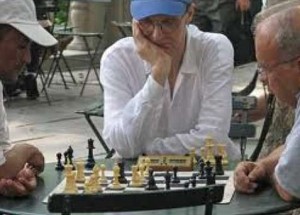by Jack Lee
 Ever since my friend, Ruth told me about this chess site I’ve been having a lot of fun playing. Recently I’ve learned it can be good for your brain too! But, for now I’m just having fun…played almost 140 games in 1 month!
Ever since my friend, Ruth told me about this chess site I’ve been having a lot of fun playing. Recently I’ve learned it can be good for your brain too! But, for now I’m just having fun…played almost 140 games in 1 month!
I’ve played people from around the world – the site is available 24/7. It’s located at chess.com and I know I mentioned it before, but it’s been great, no problems.
I’ve been improving my game steadily because of the chess training and tutors over there.
For years I’ve been locked into one level of play, but after working the chess exercises (solving plays by grand masters) I finally started to see some progress. The USCF recommends it, so it can’t be a dangerous site, least not anymore than anything else on the web and it’s free.
There’s some evidence that it could help in preventing the onset of age related dementia and help with a lot more. Check this out:
“Chess has always had an image problem, being seen as a game for brainiacs and people with already high IQs. So there has been a bit of a chicken-and-egg situation: do smart people gravitate towards chess, or does playing chess make them smart? At least one study has shown that moving those knights and rooks around can in fact raise a person’s intelligence quotient. A study of 4,000 Venezuelan students produced significant rises in the IQ scores of both boys and girls after 4 months of chess instruction.
2. It helps prevent Alzheimer’s
Because the brain works like a muscle, it needs exercise like any bicep or quad to be healthy and ward off injury. A recent study featured in The New England Journal of Medicine found that people over 75 who engage in brain-stretching activities like chess are less likely to develop dementia than their non-board-game-playing peers. Just like an un-exercised muscle loses strength, Dr. Robert Freidland, the study’s author, found that unused brain tissue leads to a loss of brain power. So that’s all the more reason to play chess before you turn 75.
3. It exercises both sides of the brain
In a German study, researchers showed chess experts and novices simple geometric shapes and chess positions and measured the subjects’ reactions in identifying them. They expected to find the experts’ left brains being much more active, but they did not expect the right hemisphere of the brain to do so as well. Their reaction times to the simple shapes were the same, but the experts were using both sides of their brains to more quickly respond to the chess position questions.
4. It increases your creativity
Since the right hemisphere of the brain is responsible for creativity, it should come as no surprise that activating the right side of your brain helps develop your creative side. Specifically, chess greatly increases originality. One four-year study had students from grades 7 to 9 play chess, use computers, or do other activities once a week for 32 weeks to see which activity fostered the most growth in creative thinking. The chess group scored higher in all measures of creativity, with originality being their biggest area of gain.
5. It improves your memory
Chess players know — as an anecdote — that playing chess improves your memory. Being a good player means remembering how your opponent has operated in the past and recalling moves that have helped you win before. But there’s hard evidence also. In a two-year study in 1985, young students who were given regular opportunities to play chess improved their grades in all subjects, and their teachers noticed better memory and better organizational skills in the kids. A similar study of Pennsylvania sixth-graders found similar results. Students who had never before played chess improved their memories and verbal skills after playing.”
6. It increases problem-solving skills
A chess match is like one big puzzle that needs solving, and solving on the fly, because your opponent is constantly changing the parameters. Nearly 450 fifth-grade students were split into three groups in a 1992 study in New Brunswick. Group A was the control group and went through the traditional math curriculum. Group B supplemented the math with chess instruction after first grade, and Group C began the chess in first grade. On a standardized test, Group C’s grades went up to 81.2% from 62% and outpaced Group A by 21.46%.”
Click here to read the rest of the article.
